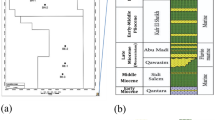Abstract
The current study represents evaluation of petrophysical properties for Khasib Formation in four wells of Amara oil field (Am-1, Am-2, Am-5, and Am-6). The petrophysical evaluation was based on well logs and core plug data to delineate the petrophysical characteristics of Khasib Formation. The available well logs such as (sonic, density, neutron, gamma ray, SP, and resistivity logs) are digitized using the Didger software package. The environmental corrections and petrophysical parameters such as porosity, water saturation, hydrocarbon saturation, bulk water volume, etc. were computed and interpreted using Interactive Petrophysics program. Net-to-gross (NTG) values of Khasib reservoir were calculated using core plug data (porosity and permeability). Lithological and mineralogical studies using porosity combination cross plots show that Khasib Formation consists mainly of limestone with shale at the bottom of the formation and the essential mineral components are dominantly calcite. Interpretation of petrophysical characteristics indicate that the Khasib Formation consists of three units: upper Khasib, middle Khasib, and lower Khasib. Middle Khasib represents the principal oil-bearing unit in Khasib Formation.














Similar content being viewed by others
Abbreviations
- Am-1:
-
Amara Well-1
- Am-2:
-
Amara Well-2
- Am-5:
-
Amara Well-5
- Am-6:
-
Amara Well-6
- a:
-
Tortuosity factor
- BVW:
-
Bulk volume water
- CPI:
-
Computer Processing Interpretation
- F:
-
formation resistivity factor
- GR:
-
Gamma ray log
- m:
-
cementation exponent in Archie equation
- n:
-
saturation exponent in Archie equation
- PHIN:
-
Neutron log
- PHIT:
-
Total porosity
- PHIE:
-
Effective porosity
- RHOB:
-
Density log
- Rw:
-
Resistivity of water formation
- Rt:
-
Resistivity of uninvaded zone
- Rxo:
-
Resistivity of invaded zone
- Sw:
-
water saturation in uninvaded zone
- Sxo:
-
Water saturation in invaded zone
- SPI:
-
Secondary porosity index
- Δtma:
-
sonis transit time in rock matrix
- Δtmaa:
-
Apparent sonis transit time in rock matrix
- ΔT (DT):
-
Sonic transit time
References
Archie GE (1942) The electrical resistivity log as an aid in determining some reservoir characteristics. AIME 146:54
Asquith GB, Krygowski D (2004) Basic well log analysis, 2nd edition: AAPG methods in exploration series 16. The American Association of Petroleum Geologists, Oklahoma, 244p
Desbrandes R 1985 Encyclopedia of well logging
Dresser Atlas (1979) Log interpretation charts. Dresser Industries, Inc, Houston, p 107
Ghorab M, Mohmed AMR, Nouh AZ (2008) The relation between the shale origin (source or non-source) and its type for Abu Roash Formation at Wadi El-Natrun area, south of Western Desert, Egypt. Australian J Basic Appl Sci 2(3):360–371
Hilchie DW (1978) Applied open hole log interpretation. D. W. Hilchie, Inc., Colorado, 309 p
Jassim SZ, Goff JC (2006) Geology of Iraq. Dolin, Prague and Moravian Museum, Brno, 341p
Katz AJ, Thompson AH (1986) Qualitative prediction of permeability in porous rock. Physical Review B 34:879–881
Levrson LA (1972) Geology of petroleum 2nd ed. Freeman, W.H. and Company, Pub, San Francisco, p 724
Missan Oil Company. Final well reports for (Am-1, Am-2,), Reservoir and Fields Development Department
Schlumberger 1974 Log interpretation, vol. II-applications: New York
Schlumberger (1997) Log interpretation charts. Schlumberger Wireline and Testing, Houston, p 193
Schlumberger (1998) Cased hole log interpretation principles/applications. Schlumberger Wireline and Testing, Houston, p 198
Schlumberger 2011 log interpretation chartbook. Schlumberger, 151p
Wyllie MRJ, Gregory AR, Gardner GHF (1958) An experimental investigation of the factors affecting elastic wave velocities in porous media. Geophysics 23:459–493
Author information
Authors and Affiliations
Corresponding author
Rights and permissions
About this article
Cite this article
Al-Baldawi, B.A. Petrophysical evaluation study of Khasib Formation in Amara oil field, South Eastern Iraq. Arab J Geosci 8, 2051–2059 (2015). https://doi.org/10.1007/s12517-014-1371-5
Received:
Accepted:
Published:
Issue Date:
DOI: https://doi.org/10.1007/s12517-014-1371-5




